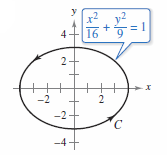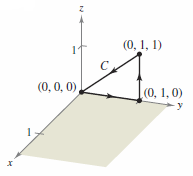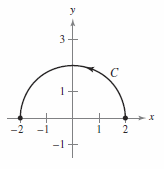Calculus III Advanced (Course) (15.02) (Homework)
Contents
- 1 Section 15.2 Homework
- 1.1 Exercise 15.2.6 Finding a Piecewise Smooth Parametrization
- 1.2 Exercise 15.2.10 Evaluating a Line Integral
- 1.3 Exercise 15.2.20 Finding a Parametrization and Evaluating a Line Integral
- 1.4 Exercise 15.2.22 Mass
- 1.5 Exercise 15.2.30 Evaluating a Line Integral of a Vector Field
- 1.6 Exercise 15.2.38 Work
- 1.7 Exercise 15.2.54 Evaluating a Line Integral in Differential Form
- 2 Internal Links
Section 15.2 Homework
From Calculus 10e by Larson and Edwards, p. 1061. Exercises 6, 10, 20, 22, 30, 38, 54.
Exercise 15.2.6 Finding a Piecewise Smooth Parametrization
|
|
Find a piecewise smooth parametrization for path \(C\), as shown in Figure 1.
|
Exercise 15.2.10 Evaluating a Line Integral
Evaluate the line integral along the given path.
- $$\int_{C} 2xyz \: ds $$
- \(C: \: \textbf{r}(t) = 12t\textbf{i}+5t\textbf{j}+84t\textbf{k}, \: 0 \leqslant t \leqslant 1\)
Solution Start with a smooth parametrization.
| \(\textbf{r}^{\prime}(t) \) | \(=12+5+84 \) |
| \(= \sqrt{12^{2}+5^{2}+84^{2} } =85\) |
| $$\int_{C} 2xyz \: ds $$ | $$=\int_{0}^{1} (2)(12t)(5t)(84t)(85)\:dt $$ |
| $$= 856,800\int_{0}^{1} t^{3} \: dt$$ | |
| $$= 856,800 \left[ \frac{1}{4} t^{4} \right]_{0}^{1}=214,200 $$ |
Exercise 15.2.20 Finding a Parametrization and Evaluating a Line Integral
|
|
(a) find a piecewise smooth parametrization for the path \(C\) shown in Figure 2.
along \(C\).
|
Exercise 15.2.22 Mass
Find the total mass for a spring with two turns and density \(\rho\) shaped as a circular helix
- \(\textbf{r}(t) = 2 \cos t\textbf{i}+ 2 \sin t\textbf{j}+ t\textbf{k}, \: 0 \leqslant t \leqslant 4 \pi\).
- \(\rho(x,y,z) = z.\)
Exercise 15.2.30 Evaluating a Line Integral of a Vector Field
Evaluate
- $$ \int_{C} \textbf{F} \cdot \: d\textbf{r}$$
where \(C\) is represented by \(\textbf{r}(t)\).
- \(\textbf{F}(x,y) = 3x\textbf{i}+4y\textbf{j}\)
\(C\): \(\textbf{r}(t)= t\textbf{i} + \sqrt{4-t^{2}}\textbf{j}, \: -2 \leqslant t \leqslant 2\).
Exercise 15.2.38 Work
|
|
Find the work done by the force field \(\textbf{F}\) on a particle moving along the path shown in Figure 3.
\(C\): counterclockwise along the semicircle \(y=\sqrt{4-x^{2}}\) from \((2,0)\) to \((-2,0)\). |
Exercise 15.2.54 Evaluating a Line Integral in Differential Form
Evaluate the integral
- $$\int_{C} 93y-x) \: dx + y^{2} \: dy $$
Internal Links
Parent Article: Calculus III Advanced (Course)


